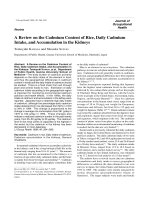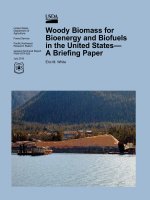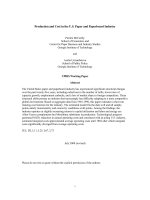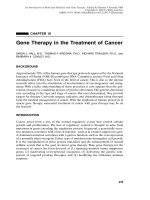Synthesis of Fe3O4-reduced graphene oxide modified tissue paper and application in the treatment of methylene blue
Bạn đang xem bản rút gọn của tài liệu. Xem và tải ngay bản đầy đủ của tài liệu tại đây (739.02 KB, 8 trang )
VNU Journal of Science: Natural Sciences and Technology, Vol. 35, No. 3 (2019) 56-63
Original Article
Synthesis of Fe3O4-Reduced Graphene Oxide Modified
Tissue-Paper and Application in the Treatment
of Methylene Blue
Le Thanh Huyen, Dao Sy Duc, Nguyen Xuan Hoan,
Nguyen Huu Tho, Nguyen Xuan Viet
Faculty of Chemistry, VNU University of Science, 19 Le Thanh Tong, Hanoi, Vietnam
Received 08 April 2019
Revised 24 July 2019; Accepted 30 July 2019
Abstract: Graphene-based composites have received a great deal of attention in recent year because
the presence of graphene can enhance the conductivity, strength of bulk materials and help create
composites with superior qualities. Moreover, the incorporation of metal oxide nanoparticles such
as Fe3O4 can improve the catalytic efficiency of composite material. In this work, we have
synthesized a composite material with the combination of reduced graphene oxide (rGO), and Fe 3O4
modified tissue-paper (mGO-PP) via a simple hydrothermal method, which improved the removal
efficiency of the of methylene blue (MB) in water. MB blue is used as the model of contaminant to
evaluate the catalytic efficiency of synthesized material by using a Fenton-like reaction. The
obtained materials were characterized by SEM, XRD. The removal of materials with methylene blue
is investigated by UV-VIS spectroscopy, and the result shows that mGO-PP composite is the
potential composite for the color removed which has the removal efficiency reaching 65% in acetate
buffer pH = 3 with the optimal time is 7 h.
Keywords: graphene-based composite, methylene blue, Fenton-like reaction
________
Corresponding author.
Email address:
/>
56
L.T. Huyen et al. / VNU Journal of Science: Natural Sciences and Technology, Vol. 35, No. 3 (2019) 56-63
1. Introduction
Wastewater treatment has received great
attention because of its negative impacts on
human life and health. There are various types of
wastewater,
however,
colored
organic
wastewater is one of the most consideration
because it does affect not only human health but
also aquatic life. Therefore, the proper treatment
of wastewater is necessary [1, 2].
In this report, methylene blue (MB) is
employed as a model of the contaminant to
evaluate the color processing ability of the
synthesized material. MB is a basic dye which
has the molecular formula C16H18N3ClS (MW:
319.85 g/mol), and the structure is shown below
[3].
N
ClCH3
CH3
N
CH3
S
N
CH3
Fig. 1. Structure of methylene blue.
A variety of colored removal technologies is
approached for wastewater treatment [1] such as
biological degradation, physical or physicchemical techniques, chemical techniques, and
electrochemical techniques. Each of those
showed the ability in the removal of colorants
and has both advantages and disadvantages. For
instance, biological degradation is considered to
be low-cost, environmentally friendly [4].
However, it is difficult to apply on a large-scale
and not effective with the high concentration of
pollutants. Physical or physic-chemical
techniques can cause sludge formation, using a
large amount of chemicals [5].
To overcome the disadvantages of the above
techniques, it is necessary to develop a new
method which meets the requirements: high
efficiency, applicable for large-scale, active for
the wide range of organic pollutants, etc. Among
these techniques, advanced oxidation processes
(AOPs) is the most effective method which has
57
met the above requirements [6]. Moreover, to
increase the efficiency of dye treatment, many
researchers combined some AOPs such as
UV/H2O2, UV/Fenton or synthesized new
composite materials for good results [5].
The combination of reduced graphene oxide
(rGO), Fe3O4 and tissue paper form a new
material that combines the advantage of all three
components [7, 8]. rGO with large surface area
is coated onto tissue paper which not only
increases the stability of tissue paper but also
improves the ability in removing of MB via
presenting of functional groups on the surface of
rGO [9, 10]. Moreover, the presence of tissue
paper will provide a platform which helps the
attachment of nanoparticles become easier and
tightly keep it in the structure [11].
In this work, Fe3O4-reduced graphene oxide
composite was synthesized by hydrothermal
method and studied its catalytic ability in
removing of MB from aqueous solution. This
composite material is considered to be high
removal efficiency, good catalytic properties,
and it is a precursor to the production of
graphene-based materials in the future.
2. Experimental
2.1. Chemicals
Graphite powder 100% (China). H3PO4 85%
(China), H2SO4 98% (China), HCl 35% (China),
Ethanol (BDH Prolabo), H2O2 30% (China).
KMnO4 (China), KOH (Merck), FeCl3 dehydrate
(Fisher), FeSO4.7H2O (Merck), L-ascorbic acid
(BDH Prolabo), methylene blue trihydrate
(C16H18ClN3S.3H2O) (China). 3-ply tissue paper
(Fairy-Vietnam), and double-distilled water.
2.2. Procedures
2.2.1. Synthesis of graphene oxide (GO)
Pre-oxidized graphite: Graphite powder was
dispersed in 1 M HNO3 solution at a ratio of 50
g:500 mL and stirred for 30 minutes at 50 ºC.
Next, the mixture was settled for 30 minutes,
then the liquid was decanted. The solid part was
58
L.T. Huyen et al. / VNU Journal of Science: Natural Sciences and Technology, Vol. 35, No. 3 (2019) 56-63
washed by pure water on a funnel with a filter
paper. Finally, the cake of pre-oxidized graphite
was dried at 110 ºC for 24 h [12] .
A mixture of concentrated H2SO4 and H3PO4
was prepared with ratio 9:1 v/v (180 mL:20 mL)
into a round-bottom flask and placed in an ice
water pot to ensure that the temperature does not
exceed 10 ºC. After that, 2 g of pre-oxidized
graphite was added gradually to the mixture of
acids under stirring slightly. Then, 12 g of
KMnO4 was slowly added to the obtained
mixture and stirred until the mixture become
homogeneous (fig 2a). Finally, the blend was
kept at 60 ºC for 3 hours followed by cooling to
room temperature and diluting with distilled
water (fig 2b). Next, 7 mL of H2O2 was added to
the mixture to reduce KMnO4 excess into Mn2+
salts (fig 2c). The obtained GO solution was
sonicated, ionic removed by dialysis method
with 200 nm nitrocellulose membrane (fig 2d) [13].
2.2.2. Synthesis of reduced graphene oxide
modified tissue-paper (rGO-PP) composite.
a) Fabrication of GO-PP composite
A piece of three-ply tissues paper (PP) was
immersed in a GO solution with an initial
concentration of 2 mg.mL-1. GO allowed to be
absorbed by tissues paper until saturated. Then,
GO/PP was left in the drying cabinet after being
separated from the GO dispersion. This process
was repeated for three times.
b) Fabrication of reduced graphene oxide
modified tissue-paper (rGO-PP) composite
GO-PP was reduced by two reducing agents:
ascorbic acid and dimethylformamide (DMF)
which was followed by the procedure as below:
Ascorbic acid: GO-PP was put into a
Teflon-lined autoclave containing 0.1 M
ascorbic acid. Then it was heated at 100 ºC for 6
h to reduce GO. After cooling down to room
temperature naturally, the product was washed
with double-distilled water (DDW) and ethanol,
respectively [14].
DMF: GO-PP was put into a Teflon-lined
autoclave containing 1:1 v/v DMF: H2O. Next, it
was heated at 160 ºC for 5 h to reduce GO. Then,
it was cooled down to room temperature
naturally followed by washing with DDW and
ethanol, respectively [15].
c) Fabrication of magnetic-reduced
graphene oxide modified tissue-paper (mGOPP) composite
GO-PP was put into a Teflon-lined autoclave
containing the mixture of 0.1 M Fe2+, 0.1 M Fe3+
with the mole ratio of 1:1. After that, KOH 6 M
is added to the mixture such that the pH value
reaches 10. Next, it was heated at 100 ºC for 6 h.
Then, it was washed in turn with DDW and
ethanol after cooling down to room temperature
naturally [16].
2.3. Characterization
The morphology of obtained materials was
observed by SEM using Hitachi S-4800 with an
accelerating voltage of 15 kV. XRD pattern was
acquired with a Bruker D8 diffractometer using
Cu Kα radiation (1.5418 Å). The size
distribution of GO using in this study was carried
out on Laser diffraction particle size analyzer
(SHIMADZU SALD-2101). The conductivity of
the composite was conducted on a two-probe
electric-multimeter
(HIOKI
3801-Digital
HiTESTER - Japan).
The color of the solution changed from darkgreen to dark-brown which is the evidence for
the successfully oxidized from graphite to GO.
Fig. 3. shows an XRD pattern of graphite
and graphene oxide and size distribution of
obtained GO. The XRD pattern of graphite has a
peak with high intensity at 2θ = 26º [17]. After
oxidized by strong oxidation agents such as
H2SO4, and KMnO4, the XRD pattern of GO
appear high-intensity peak at 2θ of 11º [17]. This
phenomenon shows that the distance between
layers in the structure is amplified by the
presence of polar groups such as –OH, –COC–,
–COO- on the surface. It can be seen clearly that
the size distribution of synthesized GO material
is quite evenly and centrally in the range of 1÷4
μm (fig 3b).
L.T. Huyen et al. / VNU Journal of Science: Natural Sciences and Technology, Vol. 35, No. 3 (2019) 56-63
59
3. Results and discussions
3.1. Synthesis of GO and characteristics
Fig. 3. XRD patterns of graphite and graphene oxide
and particle size distribution diagram of GO.
3.2. rGO-PP composite and characteristics
The photographs of synthesized composites
are shown in Fig. 4.. They all show black and
uniform distribution of color on the tissue paper
substrate.
Fig. 2. Synthesis of GO from graphite by
modified Hummer's method, a) the mixture of acids
and graphite after KMnO4 added; b) the reaction
mixture after continuously stirring at 60 ºC for 3
hours; c) the reaction mixture after cooled and
reacted with H2O2; d) GO solution obtained after
sonication, ionic removal by dialysis method with
200 nm nitrocellulose membrane.
Fig. 4. Photographs of synthesized composites:
a) GO; b) rGO-Asc (using ascorbic acid as reducing
agent); c) rGO-DMF (using DMF as reducing
agent); d) comparison between rGO-Asc (left) and
GO (right); e) comparison between rGO-Asc (left)
and GO (right).
60
L.T. Huyen et al. / VNU Journal of Science: Natural Sciences and Technology, Vol. 35, No. 3 (2019) 56-63
Table 1. Electrical conductivity of GO-PP and rGO
PP composite
Materials
GOPP
Conductivity
(mS.cm-1)
0
rGOAsc
3.24102
rGODMF
1.2810-2
As seen from the Fig. 4., rGO has a brighter
color than GO, and the data in Table 1 show that
GO-PP is a non-conductive material while rGOPP is a conductive material and the reduction by
Asc is more effective than DMF which is shown
in the higher electrical conductivity of rGO-Asc
in comparison with rGO-DMF. This is the
evidence for the successfully reduced GO to
rGO.
3.3. Catalytic ability of the composite materials
to MB
MB solutions were prepared in the range of
1-10 ppm with a buffer solution pH=3. A
baseline of the buffer was measured, then the
maximum absorption (UV-vis spectroscopy)
wavelength (max) of the MB solution at 6 ppm
was determined with the value of max = 664 nm.
The optical absorption of the MB solution at max
with the different concentrations from 1 ppm to
8 ppm was conducted. The calibration curve was
constructed, and the plot is shown in Fig. 6. from
the obtained data.
Fig. 6. Calibration curve of MB solution in a buffer
solution pH=3.
Fig. 5. SEM images of tissue paper (PP), GO-PP,
rGO-PP, and mGO-PP.
SEM images were observed at the various
magnification, showing the surface morphology
of the materials. It is obvious to see from Fig. 5.
that the surfaces of composite become less
roughness than tissue paper after graphene oxide
is coated on the surface. Besides, the SEM
images of mGO-PP sample show a dense
distribution of Fe3O4 nano-rods on the material
surface. This is the evidence for the successful
synthesis of the magnetic material on the GO-PP
platform becoming a potential candidate for high
treatment efficiency to colored organic substances.
The GO-PP was transferred into a beaker
containing 7 mL of 8 ppm MB in the buffer
solution at pH = 3. The solution was measured
the value of optical absorption by UV-Vis
equipment after 1.5 h, 3 h, 5 h, 7 h. The results
are shown in Table 2:
Table 2. Effect of adsorption time on the removal
efficiency of MB
Time (h)
Abs
CMB treated (ppm)
H (%)
1.5
0.927
3.43
42.88
3
0.831
3.87
48.37
5
0.606
4.90
61.30
7
0.318
6.23
77.86
In which, CMB treated and H (%) are calculated
by the formula:
L.T. Huyen et al. / VNU Journal of Science: Natural Sciences and Technology, Vol. 35, No. 3 (2019) 56-63
𝐶𝑀𝐵 𝑡𝑟𝑒𝑎𝑡𝑒𝑑 = 𝐶𝑀𝐵 𝑖𝑛𝑖𝑡𝑖𝑎𝑙 − 𝐶𝑀𝐵 𝑚𝑒𝑎𝑠𝑢𝑟𝑒𝑑 𝑡𝑖𝑚𝑒
= 𝐶𝑀𝐵 𝑖𝑛𝑖𝑡𝑖𝑎𝑙 −
𝐴𝑏𝑠+0.0673
0.2176
By using the calibration curve, we can
calculate the removal efficiency of MB by the
equation:
𝐶𝑀𝐵 𝑡𝑟𝑒𝑎𝑡𝑒𝑑
𝐻% =
× 100%
𝐶𝑀𝐵 𝑖𝑛𝑖𝑡𝑖𝑎𝑙
The obtained results are shown as follow:
Fig. 7. Effect of adsorption time on the removal
efficiency of MB.
The MB removal efficiency of materials at
time longer than 7 h did not show the increase.
Therefore, the optimal time is 7 h.
3.3.1. Effect of H2O2 on the remove of MB
The effect of H2O2 to removing of MB was
conducted as below: the same amount of MB
was poured into two conical flasks after that one
is added H2O2 solution such that its
concentration is 20 mM, the other condition is
kept unchanged. After 7 h, measure the
absorbance of MB in two conical flasks and
compare them to conclude the effect of H2O2.
The result is shown in Table 3.
61
than that of MB with the absence of H2O2.
Because H2O2 can be decomposed to generate
free radical which is very active, so it can
increase the degradation rate of MB and cause a
decrease in MB absorbance.
3.3.2. Efficiency of composite materials on
the treatment of MB
The procedure is conducted as similar to the
above description, but H2O2 solution is absent or
present in the mixture and its concentration is 20
mM. The results are shown in Fig. 8. . It can be
seen that the presence of rGO in GO-PP, rGOPP, and mGO-PP enhanced the removal
efficiency largely compared with that on PP
only. The results could be explained by the high
surface area and remain function groups
(hydroxide, carbonyl, carboxylic, etc.) on the
surface of the rGO, which have electrostatic
interaction with MB in aqueous solution [10].
Among these materials, mGO-PP composite
shows its potential with the load of 2.433 mg.g-1
and the efficiency reaches 65%.
When H2O2 is added, the main reaction is
occurred as below [6, 18]:
Fe2+ + H2O2 → Fe3+ + •OH + OH−
(1)
•
HO + organic compounds → intermediates
→ CO2 + xH2O (2)
Because •OH radicals are very active, it can
increase the decomposition of MB leading the
increase in removal efficiency of MB.
Table 3. The effect of H2O2 on the MB solution
Sample
Abs
MB
1.675
MB + H2O2
1.521
After 7 hours, the absorbance value of the
MB solution in the presence of H2O2 is smaller
Fig. 8. Comparison of the removal efficiency
of the composites in the case with/without the
presence of H2O2.
62
L.T. Huyen et al. / VNU Journal of Science: Natural Sciences and Technology, Vol. 35, No. 3 (2019) 56-63
It can be seen that the removal efficiency is
higher in the presence of H2O2. Because in the
presence of H2O2, it is not only the adsorption
process but also the oxidation process occurring
in the reaction time, while only the adsorption
process occurs if H2O2 is not added.
4. Conclusions
GO has been successfully synthesized from
graphite by the modified Hummer's method with
uniform size distribution ranging from 1 to 4 μm.
rGO-PP and mGO-PP composite have been also
synthesized by the simple hydrothermal method.
The composites were applied to remove MB
from aqueous solution. At the optimal condition,
the MB removal efficiency on mGO-PP
composite reached 65% and was higher than that
of PP, GO-PP and rGO-PP composite materials.
The ability of mGO-PP composite in color
removal broaden the choice of materials in the
field of water treatment.
Acknowledgments
This research is funded by Vietnam National
Foundation for Science and Technology
Development (NAFOSTED) under grant
number 103.99-2016.38.
References
[1] Ma Joshi, Rue Bansal, Reng Purwar, Colour
removal from textile effluents, Indian Journal of
Fibre & Textile Research, 29 (2004) 239-259
/>31.
[4] Qin Qingdong, Ma Jun, Liu Ke, Adsorption of
anionic dyes on ammonium-functionalized
MCM-41, Journal of Hazardous Materials, 162
(2009) 133-139 />2008.05.016.
[5] Mui Muruganandham, Rps Suri, Sh Jafari, Mao
Sillanpää, Lee Gang-Juan, Jaj Wu, Muo
Swaminathan,
Recent
developments
in
homogeneous advanced oxidation processes for
water and wastewater treatment, International
Journal of Photoenergy, 2014 (2014). http://dx.
doi.org/10.1155/2014/821674.
[6] Herney Ramirez, Vicente Miguel , Madeira Luis
Heterogeneous photo-Fenton oxidation with
pillared clay-based catalysts for wastewater
treatment: a review, Applied Catalysis B:
Environmental, 98 (2010) 10-26 />10.1016/j.apcatb.2010.05.004.
[7] Guo Rong, Jiao Tifeng, Li Ruifei, Chen Yan, Guo
Wanchun, Zhang Lexin, Zhou Jingxin, Zhang
Qingrui,
Peng
Qiuming,
Sandwiched
Fe3O4/carboxylate
graphene
oxide
nanostructures constructed by layer-by-layer
assembly for highly efficient and magnetically
recyclable dye removal, ACS Sustainable
Chemistry & Engineering, 6 (2017) 1279-1288
/>[8] Sun Chao, Yang Sheng-Tao, Gao Zhenjie, Yang
Shengnan, Yilihamu Ailimire, Ma Qiang, Zhao
Ru-Song, Xue Fumin, Fe3O4/TiO2/reduced
graphene oxide composites as highly efficient
Fenton-like catalyst for the decoloration of
methylene blue, Materials Chemistry and
Physics, 223 (2019) 751-757 />10.1016/j.matchemphys.2018.11.056.
[9] Guo Hui, Ma Xinfeng, Wang Chubei, Zhou
Jianwei, Huang Jianxin, Wang Zijin, SulfhydrylFunctionalized Reduced Graphene Oxide and
Adsorption of Methylene Blue, Environmental
Engineering Science, 36 (2019) 81-89 https://doi.
org/10.1089/ees.2018.0157.
[2] Kannan Nagar, Sundaram Mariappan, Kinetics and
mechanism of removal of methylene blue by
adsorption on various carbons-a comparative
study, Dyes and pigments, 51 (2001) 25-40
/>
[10] Zhao Lianqin, Yang Sheng-Tao, Feng Shicheng,
Ma Qiang, Peng Xiaoling, Wu Deyi, Preparation
and application of carboxylated graphene oxide
sponge in dye removal, International journal of
environmental research and public health, 14
(2017) 1301 />
[3] K Rastogi, J. N Sahu, B. C Meikap, M. N Biswas,
Removal of methylene blue from wastewater
using fly ash as an adsorbent by hydrocyclone,
Journal of hazardous materials, 158 (2008) 531540. 105.
[11] Yu Dandan, Wang Hua, Yang Jie, Niu Zhiqiang,
Lu Huiting, Yang Yun, Cheng Liwei, Guo Lin,
Dye wastewater cleanup by graphene composite
paper for tailorable supercapacitors, ACS applied
L.T. Huyen et al. / VNU Journal of Science: Natural Sciences and Technology, Vol. 35, No. 3 (2019) 56-63
materials & interfaces, 9 (2017) 21298-21306
/>[12] Wang Hou, Yuan Xingzhong, Wu Yan, Huang
Huajun, Peng Xin, Zeng Guangming, Zhong
Hua, Liang Jie, Ren MiaoMiao, Graphene-based
materials: fabrication, characterization and
application for the decontamination of
wastewater and wastegas and hydrogen
storage/generation, Advances in Colloid and
Interface Science, 195 (2013) 19-40 https://doi.
org/10.1016/j.cis.2013.03.009.
[13] Marcano Daniela C, Kosynkin Dmitry V, Berlin
Jacob M, Sinitskii Alexander, Sun Zhengzong,
Slesarev Alexander, Alemany Lawrence B, Lu
Wei, Tour James M, Improved synthesis of
graphene oxide, ACS nano, 4 (2010) 4806-4814
/>[14] Zhang Jiali, Yang Haijun, Shen Guangxia, Cheng
Ping, Zhang Jingyan, Guo Shouwu, Reduction of
graphene oxide via L-ascorbic acid, Chemical
Communications, 46 (2010) 1112-1114 http://doi.
org/10.1039/B917705A
[15] Gong Ming, Zhou Wu, Tsai Mon-Che, Zhou
Jigang, Guan Mingyun, Lin Meng-Chang, Zhang
63
Bo, Hu Yongfeng, Wang Di-Yan, Yang Jiang,
Nanoscale nickel oxide/nickel heterostructures
for active hydrogen evolution electrocatalysis,
Nature communications, 5 (2014) 4695 https://
doi.org/10.1038/ncomms5695.
[16] Wu Zhong-Shuai, Yang Shubin, Sun Yi, Parvez
Khaled, Feng Xinliang, Müllen Klaus, 3D
nitrogen-doped graphene aerogel-supported
Fe3O4 nanoparticles as efficient electrocatalysts
for the oxygen reduction reaction, Journal of the
American Chemical Society, 134 (2012) 90829085 />[17] Nguyen Son Truong, Nguyen Hoa Tien, Rinaldi
Ali, Nguyen Nam Van, Fan Zeng, Duong Hai
Minh, Morphology control and thermal stability
of binderless-graphene aerogels from graphite for
energy storage applications, Colloids and
Surfaces A: Physicochemical and Engineering
Aspects, 414 (2012) 352-358 />10.1016/j.colsurfa.2012.08.048.
[18] Deng Yang, Englehardt James D, Treatment of
landfill leachate by the Fenton process, Water
research, 40 (2006) 3683-3694 />10.1016/j.watres.2006.08.009.









